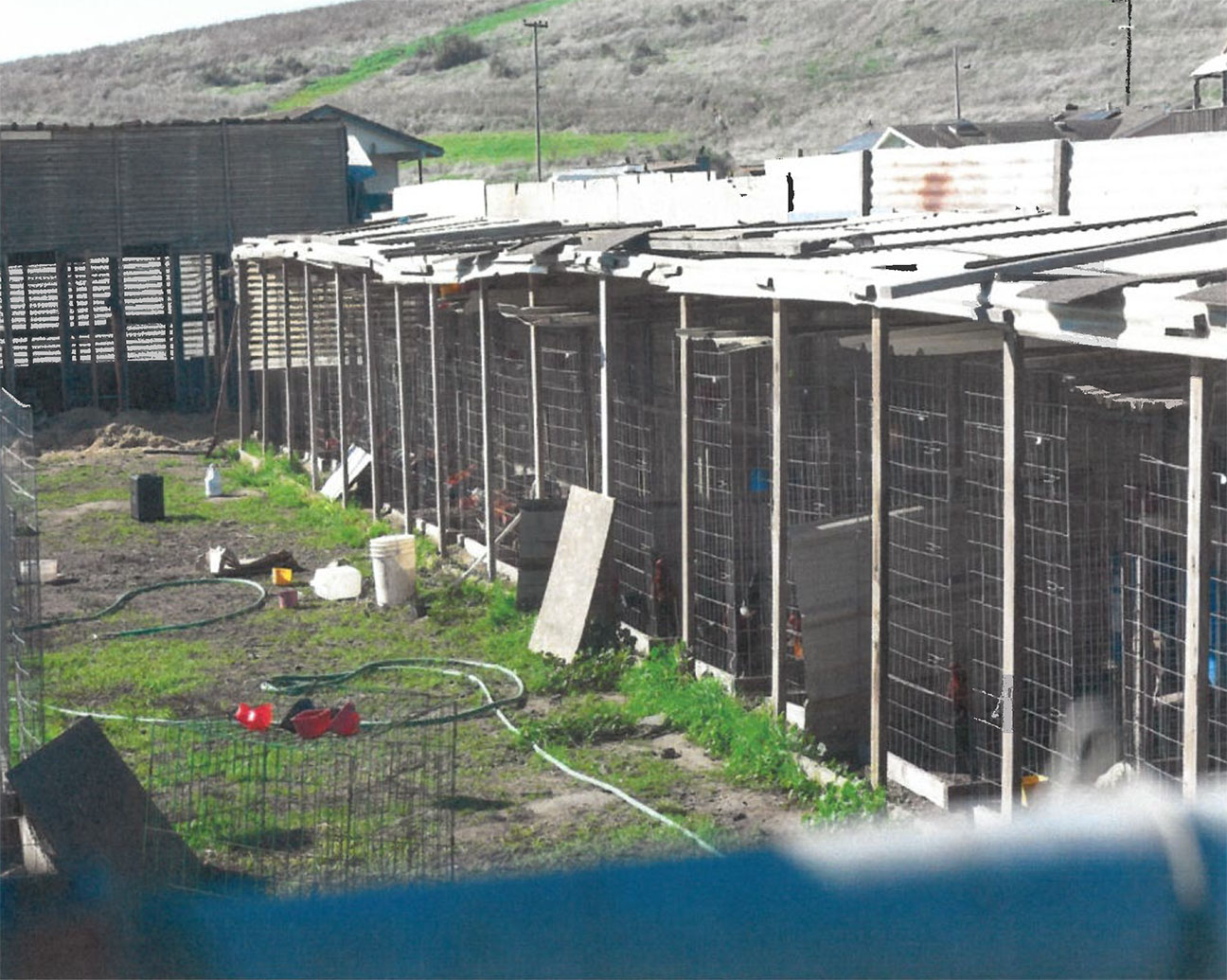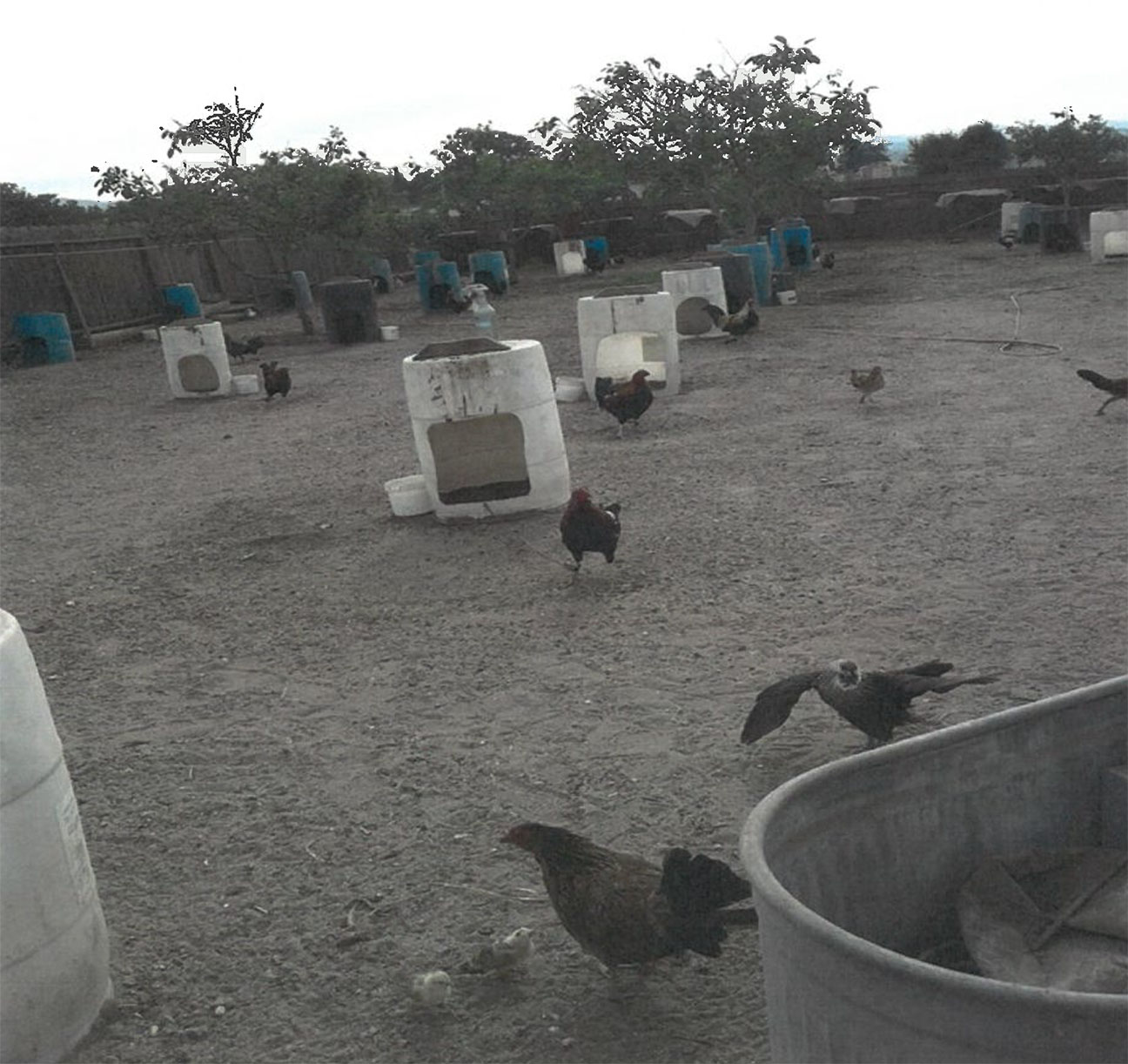By Royal Calkins
Spotting the illegal rooster-raising operations in Monterey County isn’t all that hard. Cruise the backroads around Royal Oaks or Las Lomas, little communities between Watsonville and Prunedale, and you’ll find several in plain sight, behind or beside houses and barns scattered throughout the hills.
Sometimes the roosters are in sheds part time. In some places they scratch at patches of dirt behind dilapidated fences. Some, but not many, are parts of legitimate show bird operations, but most are being raised for combat.
Acting on a complaint, members of the Monterey County civil grand jury went out earlier this year and quickly found plenty of the fighting variety — more than enough to lead to the conclusion that county officials are simply ignoring the county’s 2014 ordinance intended to control the apparently growing industry of raising and selling roosters destined to win or die in the ring. The grand jury used cameras mounted on drones to document a concentration of rooster businesses in the Royal Oaks area and used Google Earth images to find dozens more elsewhere in the county.
The grand jury estimated there could be as many as 1,000 illegal backyard operations in the county, but the jurors provided little support for that conclusion.
In the grand jury’s recently released report, a committee assigned to investigate the rooster-raising operations concluded that county officials have chosen to pretend that the Board of Supervisors didn’t mean what it said when it ruled that breeders wishing to keep five or more roosters would be required to obtain permits. The process, still largely untested, sets out a process intended to protect legitimate agricultural operations while eliminating Monterey County’s contribution to the blood sport of cockfighting.
“The Board of Supervisors had good intentions in their fight to eliminate illegal rooster keeping operations,” the grand jury reported. “Unfortunately, Monterey County agencies are operating under a process, created by Environmental Health bureau, that effectively modifies the implementation and enforcement of the ordinance. As a result, agencies are confused about their roles, have been poorly trained, and the public does not know where to turn to have their concerns addressed.”
“The restrictions contained in the ordinance are legal and justified,” the report continued. “The mechanism for enforcement is weak and illegal rooster keeping operations in Monterey County continue with impunity.“
The grand jury concluded that the county Agricultural Commissioner’s Office shares enforcement responsibilities with the Environmental Health bureau but that Environmental Health had instructed the Ag Commissioner’s Office to ignore the ordinance.
As a result, the grand jury concluded, the number of illegal rooster operations has grown dramatically in recent years, mostly in North County but also in the southern reaches of the county and remote parts of Carmel Valley.
John Ramirez, director of environmental health for the county, didn’t return phone calls from Voices though he was in the office and was left a voice message informing him of the subject matter.
A longtime county employee who deals regularly with Ramirez’s office and the county’s limited animal control operation said county employees are told that the rooster industry is among the county’s lowest enforcement priorities. While investigations of illegal bird breeding can be complicated and expensive, the budget for animal control and related activities has dramatically declined in recent years, to the point that only two employees share responsibility for animal-related enforcement efforts countywide.
“They’re told that there are lots of political and cultural issues involved and that they shouldn’t do anything unless they absolutely have to,” said the employee, who feared being fired if identified.
County officials will have an opportunity to respond to the grand jury’s criticism. Expect a promise to do better.

While the county was drafting the ordinance, rooster breeders told county officials that cockfighting is part of the Latino heritage and, therefore, deserves some measure of protection. Elsewhere, breeders have argued that cockfighting is part of the Filipino heritage, the heritage of various other Asian cultures, Pacific Islander heritage and the heritage of various Anglo populations rooted in the South.
Beth Brookhouser, director of community outreach for the Monterey County SPCA, said her organization views the grand jury report as a step in the right direction.
“We are thankful to the grand jury for investigating so thoroughly,” Brookhouser said. “This report makes it very clear who is responsible for enforcement, the roadblocks they faced, and what they need to do.”
Brookhouser said the SPCA is confident that the grand jury’s findings will prompt the county to begin enforcing the ordinance, “leading to a more humane community.”
The grand jury’s investigation was prompted by complaints from an animal rights activist who had provided several county departments with detailed information about cockfighting and rooster-breeding activities but whose efforts were ignored. The county started paying some attention to the matter only after the Monterey County Weekly published an account of her complaints last August.
The grand jury found that the unidentified county official who drafted the ordinance worked closely with a breeder with an illegal operation. The result was an ordinance designed to fail, one with layers of procedure apparently intended to create confusion, the grand jury concluded.
The Board of Supervisors enacted the ordinance after numerous North County residents complained about the noise and other problems created by concentrations of roosters. The effort to create an ordinance was led by then-Supervisor Lou Calcagno of Moss Landing but other supervisors in open session acted as though it was a trivial if not a laughing matter. Calcagno could not be reached to comment on the grand jury’s findings.

The grand jury found the problem to be beyond trivial:
“An illegal rooster keeping operation will often include hundreds of roosters kept in makeshift enclosures. Property owners frequently sublet their private property to multiple rooster owners, where they have easy access to their roosters. It is common for each rooster owner to have 50 or more roosters. The result is excessive noise, environmental pollution, health and safety issues, unsightly debris, building code violations, and the possibility of the spread of Viral Newcastle Disease, as well as other avian Zoonotic Diseases. Illegal rooster-keeping operations commonly involve illegal cockfighting or the sale of roosters for illegal cockfighting. Neighborhoods with abandoned illegal rooster keeping operations suffer depreciation of property values.
“While not the focus of our investigation, cockfighting is a magnet for prostitution, gambling, illegal drugs, firearms activity, and organized crime. … Cockfighting is considered a blood sport. It is an organized fight between two roosters, often to the death, … .bred and conditioned for increased strength and stamina. They are often injected with steroids and other drugs to increase their metabolism, making them stronger and harder to kill. Small knives are attached to their legs so that when they attack another rooster in a cock pit, blood will be quickly drawn.
“Wagers are often placed on the roosters and a winning purse can easily reach $50,000. Purses of $100,000 are not unusual.”
The county ordinance was challenged in the courts by two men involved in raising roosters, Heriberto Perez and Miguel Angel Reyes Robles, whose Facebook page is filled with rooster pictures.
They challenged the ordinance on constitutional grounds. The state 6th District Court of Appeal ruled that their petition failed largely because they couldn’t show that the ordinance had had any impact on their operations.
Have something to say about this story? Send us a letter or leave a comment below.
Cockfighting as far as I am aware is illegal. Uphold the law. Bottom line. Not to mention the MULTITUDE of reasons it is so wrong- all mentioned in the Grand Jury report. Ridiculous this is even debatedable.
Why is the shady Monterey County official who drafted the ordinance in such a way as to help protect the very people it is intended to stop described as “unidentified?” It should be a matter of record, and voters have a right to know whom to blame for intentionally deceiving us.